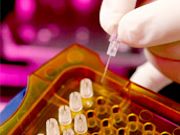Article
New Testing Method May Increase Development of Cancer Drugs
Author(s):
Tumor cells grown in mice first could potentially change the cancer research landscape.

A newly discovered approach for quickly testing hundreds of cancer drugs could reduce the amount of time it takes to find potential treatments for breast cancer, a new study published in Cell found.
The new technique involves growing human tumor cells in mice, before taking the cells out to run additional tests using experimental drugs. Growing cells in this way more accurately mimicked how cancer cells in the human body grow, and was also similar to the genetic faults that are found in cancer cells.
This way more drugs are able to be tested at the same time, and in different combinations, which could potentially shorten the time it takes to make new drugs available.
“Traditionally, we’ve grown cells on plastic dishes but this is artificial because cells in the body grow in a more complicated way,” said lead study author Carlos Caldas. “In the future, this new technique, and others like it, will replace the methods used in the lab today. We’re making all our data publically available so that other researchers around the world can use and benefit from our work and we’ll continue to improve it.”
As of now, the new technique is set to replace the current practice of growing cancer cells on plastic dishes and transferring them to mice to carry out tests, because that approach is flawed due to tumor cells growing differently in laboratory dishes than in the human body.
“Finding new ways to test potential drugs more accurately and efficiently is really important in the fight against cancer,” said Nell Barrie, Cancer Research UK’s senior science information manager. “Studies like this could help us find new treatments more quickly and might also help identify the best combinations of drugs for particular groups of patients, ensuring more people survive the disease.”






